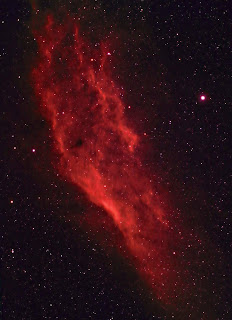As can be seen on the processing front, I need a lot of practice with PI and PS. I was very happy how the Dumbbell turned out a few weeks ago and thought this would be just as easy. There was nothing easy with this object, from collecting the subframes to final processing. Version 1 was done mostly in PI where I did minor processing on the individual NB channels prior to combining. Version 2 was stacked framed and aligned in PI but the processing on the individual NB channels was done in PS as was the combining. Neither of these images are anything to write home about but I did get something. We are expecting some cloudy weather so it looks like I will have more time to experiment with doing another version...
Version 1
Version 2
Version 3
Version 4
NGC 7380- Wizard Nebula - SHO (Hubble Palette)
Location: Home Monroe, CT
Date: 8-23-18 (Ha, OIII), 8-24-18 (OIII, SII)
Camera: ZWO ASI1600MM-Pro
Telescope: Orion ED80 80mm f/7.5 Apochromatic Refractor Telescope
Barlow: None
Focal Length: 600mm
f/7.5
Focal Reducer: Orion 0.8x Focal Reducer for Refractor Telescopes
Mount: Orion Sirius EQ
Filter Wheel: ZWO EFW 8x 1.25"
Filter: ZWO Ha, OIII, SII
Autoguiding: QHY-5L-II-M attached to an Agena 50mm Guide Scope with Helical Focuser
Exposure: Ha 41 x 180s, OIII 39 x 180, 38 X 180
Gain: 139
Offset 21
Temp: -10 C
Processing: APT, PixInsight and Photoshop
https://kurtzeppetello.smugmug.com/
Date: 8-23-18 (Ha, OIII), 8-24-18 (OIII, SII)
Camera: ZWO ASI1600MM-Pro
Telescope: Orion ED80 80mm f/7.5 Apochromatic Refractor Telescope
Barlow: None
Focal Length: 600mm
f/7.5
Focal Reducer: Orion 0.8x Focal Reducer for Refractor Telescopes
Mount: Orion Sirius EQ
Filter Wheel: ZWO EFW 8x 1.25"
Filter: ZWO Ha, OIII, SII
Autoguiding: QHY-5L-II-M attached to an Agena 50mm Guide Scope with Helical Focuser
Exposure: Ha 41 x 180s, OIII 39 x 180, 38 X 180
Gain: 139
Offset 21
Temp: -10 C
Processing: APT, PixInsight and Photoshop
https://kurtzeppetello.smugmug.com/















